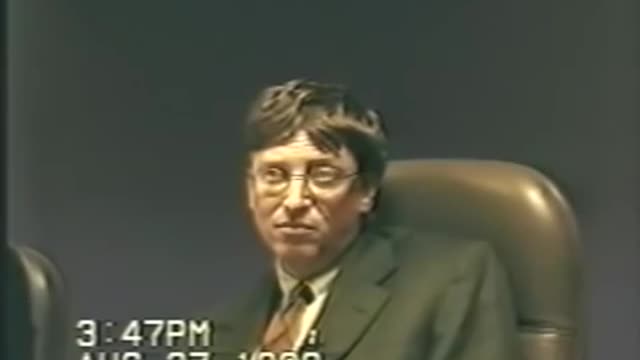Premium Only Content

Bill Gates giving his deposition to defend Microsoft monopolization attempts 1998
This article is about the 2001 antitrust lawsuit. For other cases with similar names, see United States v. Microsoft Corp. (disambiguation).
United States v. Microsoft Corp.
Seal of the Court of Appeals for the District of Columbia.png
Court United States Court of Appeals for the District of Columbia Circuit
Full case name United States of America v. Microsoft Corporation
Argued February 26–27, 2001
Decided June 28, 2001
Citation(s) 253 F.3d 34
Case history
Prior history United States v. Microsoft Corp., 87 F. Supp. 2d 30 (D.D.C. 2000); 97 F. Supp. 2d 59 (D.D.C. 2000), direct appeal denied, pet. cert. denied, 530 U.S. 1301 (2000).
Subsequent history Microsoft Corp. v. United States, 534 U.S. 952 (2001) (pet. cert. denied); 224 F. Supp. 2d 76 (D.D.C. 2002); 231 F. Supp. 2d 144 (D.D.C. 2002) (on remand), aff'd in part and rev'd in part, 373 F.3d 1199 (D.C. Cir. 2004)
Holding
The finding of the District Court that Microsoft violated the Antitrust Act is confirmed, the order of that court is reversed, and remanded for the drafting of a subsequent order.
Court membership
Judge(s) sitting Harry T. Edwards, CJ; Stephen F. Williams, Douglas H. Ginsburg, David B. Sentelle, A. Raymond Randolph, Judith W. Rogers, and David S. Tatel, JJ.
Case opinions
Per curiam
Laws applied
15 U.S.C. § 2
United States v. Microsoft Corporation, 253 F.3d 34 (D.C. Cir. 2001)[1] is a noted American antitrust law case in which the U.S. government accused Microsoft of illegally maintaining its monopoly position in the personal computer (PC) market primarily through the legal and technical restrictions it put on the abilities of PC manufacturers (OEMs) and users to uninstall Internet Explorer and use other programs such as Netscape and Java. At trial, the district court ruled that Microsoft's actions constituted unlawful monopolization under Section 2 of the Sherman Antitrust Act of 1890, and the U.S. Court of Appeals for the D.C. Circuit affirmed most of the district court's judgments.
The plaintiffs alleged that Microsoft had abused monopoly power on Intel-based personal computers in its handling of operating system and web browser integration. The issue central to the case was whether Microsoft was allowed to bundle its flagship Internet Explorer (IE) web browser software with its Windows operating system. Bundling them is alleged to have been responsible for Microsoft's victory in the browser wars as every Windows user had a copy of IE. It was further alleged that this restricted the market for competing web browsers (such as Netscape Navigator or Opera), since it typically took a while to download or purchase such software at a store. Underlying these disputes were questions over whether Microsoft had manipulated its application programming interfaces to favor IE over third-party web browsers, Microsoft's conduct in forming restrictive licensing agreements with original equipment manufacturers (OEMs), and Microsoft's intent in its course of conduct.
Microsoft argued that the merging of Windows and IE was the result of innovation and competition, that the two were now the same product and inextricably linked, and that consumers were receiving the benefits of IE free. Opponents countered that IE was still a separate product which did not need to be tied to Windows, since a separate version of IE was available for Mac OS. They also asserted that IE was not really free because its development and marketing costs may have inflated the price of Windows.
The case was tried before Judge Thomas Penfield Jackson in the United States District Court for the District of Columbia. The DOJ was initially represented by David Boies. Compared to the European decision against Microsoft, the DOJ case is focused less on interoperability and more on predatory strategies and market barriers to entry.[2
-
 2:39
2:39
BIG NEM
9 hours agoHygiene HORROR: The "Yurt Incident"
3.58K1 -
 3:19:21
3:19:21
Price of Reason
13 hours agoHollywood Celebrities FLEE the US After Trump Win! Wicked Movie Review! Gaming Journos MAD at Elon!
62.8K34 -
 3:55:45
3:55:45
Alex Zedra
8 hours agoLIVE! Last Map on The Escape: SCARY GAME.
66.2K3 -
 1:14:07
1:14:07
Glenn Greenwald
13 hours agoComedian Dave Smith On Trump's Picks, Israel, Ukraine, and More | SYSTEM UPDATE #370
165K215 -
 1:09:07
1:09:07
Donald Trump Jr.
15 hours agoBreaking News on Latest Cabinet Picks, Plus Behind the Scenes at SpaceX & Darren Beattie Joins | TRIGGERED Ep.193
203K713 -
 1:42:43
1:42:43
Roseanne Barr
11 hours ago $61.84 earnedGod Won, F*ck You | The Roseanne Barr Podcast #75
89.1K191 -
 2:08:38
2:08:38
Slightly Offensive
12 hours ago $38.02 earnedDEEP STATE WINS?! Matt Gaetz OUSTED as AG & Russia ESCALATES War | Guest: The Lectern Guy
87.1K53 -
 1:47:36
1:47:36
Precision Rifle Network
12 hours agoS3E8 Guns & Grub - the craziness continues
65.6K4 -
 41:37
41:37
Kimberly Guilfoyle
14 hours agoPresident Trump Making all the Right Moves,Live with Border Union Chief Paul Perez & Lawyer Steve Baric | Ep. 176
153K45 -
 19:38
19:38
Neil McCoy-Ward
16 hours agoMASS LAYOFFS Have Started... (How To Protect Your Income)
57.3K9